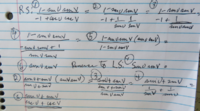Exactly. In most cases, it is a pure formailty. Indeed, if you use correctly the following notation, the formality is addressed as you goI think I can do that. I will do it tomorrow...I don't see how I can miss. All I need to do is follow the thread back on the LS.
[MATH]p = \dfrac{sin(u) + sin(b)}{csc(u) + csc(v)} \iff \\ p\{csc(u) + csc(v)\} = sin(u) + sin(v)[/MATH]In your presentation you explicitly affirm reversibility at each step. Of course if you can't show reversebility at each step, then your proof is flawed.

